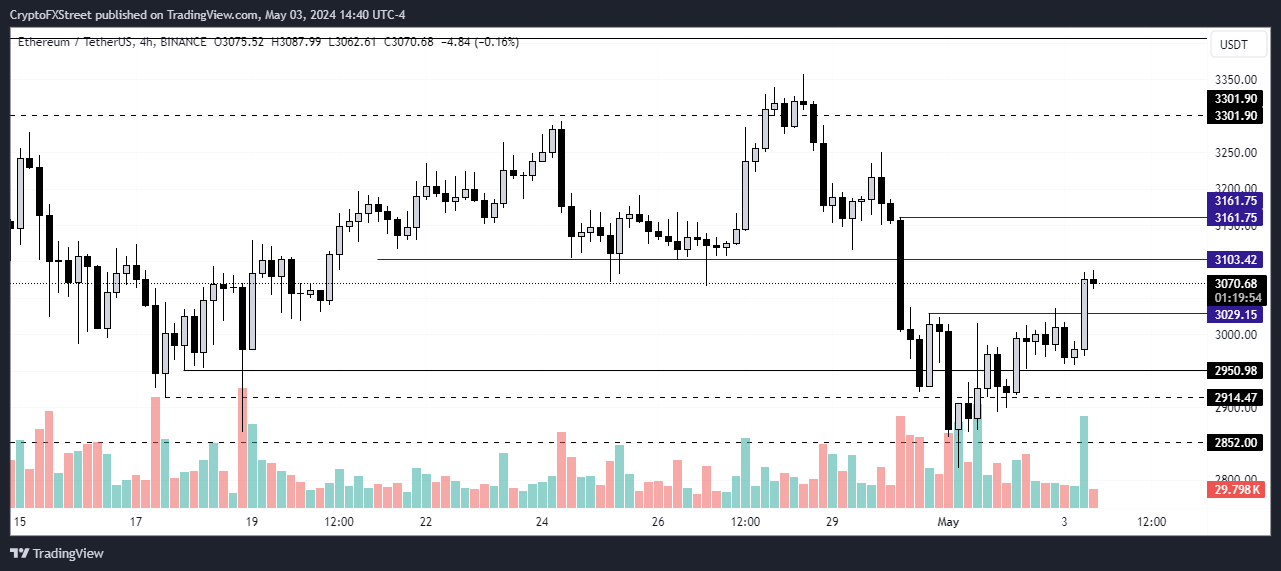- Michael Saylor says that Ethereum is a crypto asset security and spot ETH ETFs won’t be approved.
- ETH short liquidations have increased more than long in the past 24 hours.
- Recent price data indicates Ethereum could see a weekend rally.
Ethereum hints at a weekend rally on Friday following its recent price movement. However, MicroStrategy Executive Chairman Michael Saylor attempted to spoil the fun after calling ETH a security and predicting spot ETH ETFs would be rejected by the Securities & Exchange Commission (SEC).
Daily digest market movers: Michael Saylor, Hong Kong ETFs, short liquidations
Ethereum has several factors layered into its potential rally. Here are key market movers for the number one Layer 1 blockchain:
- MicroStrategy founder Michael Saylor said in a recent keynote speech on Friday that spot Ethereum ETFs won’t be approved, alleging that the second largest digital asset is deemed a “crypto asset security and not a commodity.”
He said that Ethereum, Solana, BNB, XRP, ADA and several other crypto assets are unregistered securities and would never be wrapped by a spot ETF. “None of them would be accepted by Wall Street; none of them would be accepted by mainstream institutional investors,” said Saylor.
Saylor’s comment follows doubts surrounding the SEC approving a spot Ethereum ETF in May. Several institutions, including BlackRock, ARK Invest, Grayscale, Fidelity and VanEck, have filed applications for a spot ETH ETF.
However, with recent regulatory actions targeted at Ethereum-related firms, many expect the SEC to deny these applications. Bloomberg analyst James Seyffart had earlier mentioned in an interview with Altcoin Daily that spot ETH ETFs are unlikely to happen in 2024.
Several crypto community members took to the C platform to express their thoughts on Saylor’s comment, with some disagreeing with the MicroStrategy Chairman. One user commented, “I would absolutely bet @saylor will end up being wrong about this one.”
Also read: Ethereum attempts comeback after Fed decision not to tamper with rates
- As of the Asia market close on May 3, Hong Kong Ethereum ETFs had a total trading volume of HK$5.5 million—about $715,000. This shows that the products have yet to attract investors and may not likely have much of an effect on Ethereum’s price at this time.
- Following ETH’s slight recovery, short traders have begun to see higher liquidations than long investors in the past 24 hours. Total Ethereum short liquidations sit at $21.7 million, while long liquidations are around $8.46 million, according to data from Coinglass. This indicates the market is on the verge of turning bullish as recent options data also seem bullish, according to data from Greekslive.
Technical analysis: Ethereum could see a weekend rally
Ethereum may be on the verge of a bullish move following its recent price movement. ETH broke the $3,029 key level on Friday and is looking set to tackle the resistance of $3,103 from April 26.
A successful move above this level may see ETH covering a liquidity void on April 30 and possibly entering a sideways movement. ETH may not see any bearish turn in the short term, but a key macro event could invalidate this thesis.

ETH/USDT 4-hour chart
As long liquidations trail shorts on Friday, ETH could see a considerable percentage of gains over the weekend. Bitcoin’s price movement will likely have a significant effect on how this analysis plays out.
Ethereum FAQs
Ethereum is a decentralized open-source blockchain with smart contracts functionality. Serving as the basal network for the Ether (ETH) cryptocurrency, it is the second largest crypto and largest altcoin by market capitalization. The Ethereum network is tailored for scalability, programmability, security, and decentralization, attributes that make it popular among developers.
Ethereum uses decentralized blockchain technology, where developers can build and deploy applications that are independent of the central authority. To make this easier, the network has a programming language in place, which helps users create self-executing smart contracts. A smart contract is basically a code that can be verified and allows inter-user transactions.
Staking is a process where investors grow their portfolios by locking their assets for a specified duration instead of selling them. It is used by most blockchains, especially the ones that employ Proof-of-Stake (PoS) mechanism, with users earning rewards as an incentive for committing their tokens. For most long-term cryptocurrency holders, staking is a strategy to make passive income from your assets, putting them to work in exchange for reward generation.
Ethereum transitioned from a Proof-of-Work (PoW) to a Proof-of-Stake (PoS) mechanism in an event christened “The Merge.” The transformation came as the network wanted to achieve more security, cut down on energy consumption by 99.95%, and execute new scaling solutions with a possible threshold of 100,000 transactions per second. With PoS, there are less entry barriers for miners considering the reduced energy demands.

























